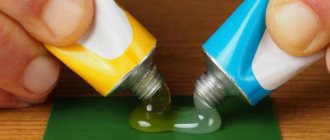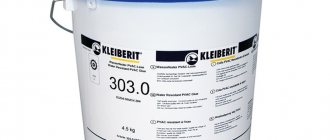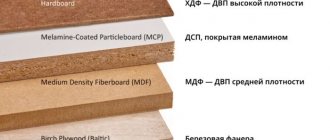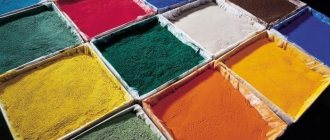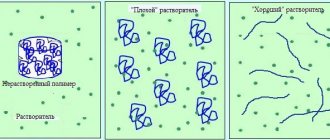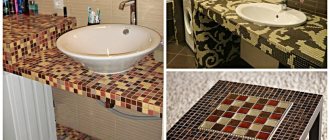Epoxy and polyester resins, the differences of which we will consider in this article, belong to the class of thermosets. This means that after the solidification process they can no longer be returned to a liquid state. Both compositions have different characteristics, which determines their scope of application. To understand the purpose of these materials, it is useful to read the overview of polyester and epoxy resins.
Epoxy resin
Epoxy is a material of synthetic origin. In its pure form, it is unsuitable for use, since it is not capable of turning into a solid state on its own. To harden, a special hardener is added to the epoxy resin in the required proportion.
To use it correctly, you need to know the pros and cons of epoxy resin. This type of resin is valued for its strength characteristics. It is resistant to aggressive chemical compounds such as acids and alkalis. The advantages of epoxy include: moderate shrinkage, high wear resistance, and excellent strength. The hardening process occurs over a wide range of temperatures, but the recommended range in everyday life is from +18 to +25 degrees. The hot curing method is used to produce high-strength products that can withstand extreme loads.
This type of resin is used both in industry and at home. The scope of their use is becoming wider thanks to the creation of new compositions with optimized properties. By mixing different types of epoxy resins and hardeners, it is possible to obtain a final product with completely different characteristics.
Advantages and disadvantages
A professional approach to comparing two materials comes down to analyzing their technical characteristics. However, “bare” indicators are unlikely to be useful for an amateur master, so we will try to evaluate these indicators, conditionally dividing them into pros and cons. Let's look at epoxy resin first. It has few disadvantages compared to its advantages, but you should not make hasty conclusions in terms of choice.
- Since the middle of the last century, epoxy resin has established itself as a reliable adhesive. Today this material is found in the form of dozens of modifications, but all of them have retained their original function. Resin is an excellent glue that “works” with almost all materials. The exceptions are polyethylenes, thermoplastics, Teflon, including plexiglass, polypropylene, polycarbonate.
- The shelf life of epoxy resin (if its components are stored separately) can reach five years, and the hardener - from 1 to 2 years. But practice shows that the main composition remains effective even after 20 years of storage. Only the proportion is violated when mixed with a hardener. It is necessary to achieve the desired properties by testing. It may be necessary to increase the amount of hardener.
- Epoxy resin in its pure form, without impurities, has no odor. It is believed that filling work should be carried out using protective equipment, since the substance in its liquid state is toxic. Firstly, modern components are environmentally friendly and do not cause harm to humans. Secondly, after curing the products have no odor. They can come into contact with skin, clothing and food. The hardener has a specific smell. It smells like ammonia. But the smell does not spread so intensely, so you can work with epoxy even in a residential area, which cannot be said about polyester resin.
- The structure of the polymer makes it waterproof. The resin layer can perform a protective function against the penetration of moisture and the action of chemically active substances. Epoxy-based enamels are used to coat pipelines and tanks.
- The viscosity index can be changed regardless of the resin model. By adding thinners or plasticizers, the master achieves the desired viscosity without losing the quality of the material. These additives are made on the basis of oligomers of epoxy groups, therefore, like the main composition, they react with the hardener and polymerize.
- A craftsman who works with epoxy has the ability to produce a product that is precise in shape and dimensions. The shrinkage of the material is 0.3-0.5% percent, and with the addition of some fillers it decreases to 0.2%.
- The density of cured epoxy resin is 20-30% less than the density of polyester. At the same time, epoxy resin does not lag behind its “competitor” in terms of strength.
Useful to know > Completely transparent epoxy resin crystal - crystal resin
The polymer also has certain disadvantages. Some of them can be minimized, but most often you have to put up with it and prioritize other indicators. One of the most significant disadvantages is the duration of the polymerization process. The first stage lasts about an hour. During this time, the product acquires the ability to maintain its shape. The resin cures over the next 24 hours. Its strength is up to 70% of the maximum value. Complete curing occurs 6-7 days after pouring.
The second disadvantage is the relatively high cost. If we are talking about production scales, then the costs of the material are quite high. Using epoxy in everyday life is worth the financial expense, provided that a high-quality result is obtained.
In the case of polyester resin, the situation is exactly the opposite. It has more disadvantages than advantages, but the small number of positive factors is of decisive importance. Let's start with the advantages.
- An undeniable advantage is the affordability of the material. On average, polyester resin is 3-5 times cheaper than epoxy. In addition, there are low costs for additional components. Thus, polymerization requires only 1-2% of the catalyst, which plays the role of a hardener, which significantly saves the budget. Let us recall that in the case of epoxy resin, the proportion of the hardener is almost equal to the proportion of the main component.
- Another advantage of the material is the speed of polymerization. Polyester resin completely hardens in 1.5-2 hours. This is very convenient, especially when creating multi-layer products. But the master must first assess his capabilities. If he fails to complete the planned work within the prescribed period, then inhibitors will have to be added to the resin to slow down the polymerization reaction.
- The hardened resin has elasticity under bending and torsion deformation. Cast slabs are elastic. In some conditions this is critical. The material can serve as a good vibration insulator. It is noteworthy that after long periodically changing loads, the properties of the resin layer do not change. But the amplitude of vibrations must be small, otherwise the structure will collapse.
Negative qualities of polyester resins are not only present, they outnumber the advantages.
- The most glaring drawback is the presence of toxic styrene. Even unsaturated resins, characterized by a low solvent content, are dangerous to human health. Therefore, you can work with resin only in a respirator, in special technical rooms equipped with good ventilation. Under no circumstances should resin be poured at home.
- Polyester resin has poor contact with epoxy. For example, if polyester is applied to epoxy, the materials will soon begin to delaminate. To create such a connection, it is recommended to pour epoxy resin onto hardened polyester resin. In the liquid state, the materials do not interact at all.
- Rapid polymerization forces the master to perform work in a hurry. It is necessary to carefully prepare for pouring so as not to waste time searching for a tool.
- If the material is poured into a mold, it is advisable to use epoxy resin, since polyester shrinks significantly. It is almost impossible to calculate the exact volume of liquid substance to obtain a workpiece of the desired shape.
- Despite the fact that many sources indicate that polyester resin has waterproofing properties, they try not to use it in conditions of high humidity. Water penetrates through the smallest pores. Polyester boats become heavier after the summer season, which indicates that the material is saturated with water. The housings have to be coated with special compounds.
- The short shelf life of the material increases the risk of purchasing polyester that has begun to polymerize. Even if the shelf life has not expired, the resin may be unsuitable for pouring if storage conditions are not met.
- Polyester resin has adhesive qualities, but they are significantly lower than those of epoxy.
Useful to know > Universal epoxy adhesive Ultima and its varieties
Application of epoxy resin
Epoxy resin is primarily used as a material for gluing surfaces: wood, leather, metal and other non-porous. This composition is in demand in electronics, mechanical engineering and aviation. Fiberglass, which is actively used in construction, is also made from epoxy. The resin is used for waterproofing floors and walls, including external ones. Finished fiberglass products after grinding and additional processing are popular in decorating interiors.
Hardener for epoxy resin
The epoxy material consists of two components, after mixing which the polymerization process begins. The component that causes epoxy resin to harden is called a hardener. Depending on the use of different resins and hardeners, completely different epoxy mixtures can be obtained.
The proportion of hardener in the composition can be different and depends mainly on the brand of resin. The polymerization reaction of epoxy resin is irreversible, that is, it is not possible to melt an already hardened material.
It is a mistake to believe that if the amount of hardener is too high, hardening will occur faster. An effective way to speed up the process is to increase the temperature of the mixture. Increasing the operating temperature by 10 degrees allows you to speed up the process by 3 times. Special components are commercially available for these purposes. There are also epoxy mixtures that harden at low temperatures.
Incorrect selection of the amount of hardener has a detrimental effect on the quality of the finished product. First of all, its strength and resistance to chemicals decreases. If there is a small amount of hardener, the consistency of the part becomes sticky; if there is an excess, the polymer is released on the surface of the material. The most common resin/hardener ratios are 1/2 or 1/1. Before mixing, it is recommended to read the instructions for the correct ratio of components.
Epoxy
Epoxy resin, like polyester resin, belongs to the class of thermosetting materials. The curing process is irreversible. When cured, the resin does not melt or dissolve. The high cost of epoxy resins limits its prevalence. However, some unique properties indicate its irreplaceability.
The resin consists of two components, one of which is the main composition. It is of neither practical nor production interest. Only in combination with the second component, a hardener, does the substance turn into a polymer with characteristic properties. The proportion of the hardener in the epoxy composition significantly exceeds the proportion of the catalyst in polyester resins. If the first is from 20 to 50%, then the second does not exceed 1%.
Professionals can obtain materials with different characteristics by combining resin brands, hardener models and their percentages. Practice shows that ordinary users do not succeed in such experiments, therefore, when using resin at home, it is recommended to follow the instructions developed by the manufacturer.
The chemical composition of epoxy resins allows the formation of bonded polymers from oligomers and polyamines. Oligomers containing epoxy groups are formed as a result of the polycondensation of epichlorohydrin with phenols. Curing of the resin occurs only when the components interact. The main component (component “A”) can be stored for a long time, since polymerization does not occur.
Polyester resin
This resin is formed during the processing of special-purpose alcohols. The basis of the material is polyester. To speed up the hardening process, specialized solvents and inhibitors are used. Depending on the scope of application of the material, it may have different structure and properties. The resulting product requires additional processing aimed at increasing protection from water and ultraviolet radiation. The additional coating also enhances the strength characteristics of the product. Polyester resin, unlike epoxy resin, is characterized by low mechanical properties. But at the same time, polyester is distinguished by its low price, due to which the material is more popular.
Such resins are actively used in the construction of buildings, in the automotive industry, shipbuilding and in the production of containers for chemical compositions. Polyester components, when mixed with glass, form highly durable compounds. Thanks to this, the resulting material is used in the manufacture of canopies, roofs for buildings and lighting fixtures.
Polyester resin is also included in artificial stone. Plastic made using this component is used in the production of window sills, shower cabins, partitions and decorative elements. Polyester resins, unlike epoxy resins, are easy to paint.
The main advantages of polyester resin
Polyester resin, unlike epoxy resin, is considered more in demand. She also has a number of positive qualities.
- The material is hard and chemical resistant.
- The resin has dielectric properties and wear resistance.
- When used, the material does not emit harmful elements, therefore it is safe for the environment and health.
When combined with glass materials, the product has increased strength, even exceeding steel. No special conditions are required for hardening; the process occurs at normal temperatures.
Unlike epoxy material, polyester resin has a low cost, so coatings are cheaper. In polyester type resin, the hardening reaction has already started, so if the material is old, it may have a solid appearance and is unsuitable for work.
Work with polyester resin is easier, and the cost of the material allows you to save on costs. But to obtain a more durable surface or high-quality bonding, epoxy material is used.
What is the difference?
When asking the question: “Which is better, polyester or epoxy?”, you need to understand why and where the resin is needed. Both materials have their pros and cons, and the final choice depends on the conditions of use as well as the type of surface the resin will be applied to.
Epoxy has a higher cost, but is more durable. Possessing excellent adhesive properties, it firmly connects surfaces of different structures. Epoxy resin differs from the polyester product due to its low shrinkage, better mechanical characteristics, and wear resistance.
At the same time, unlike polyester, epoxy takes longer to harden, which slows down the process of manufacturing parts from this material. Working with such a resin requires increased safety measures: when working with liquid material, gloves are required; when handling a solid product, a respirator is required. The danger is not so much the resin itself as the components used to give it a solid state. When hardening under high temperature conditions, there is a chance of losing the viscosity of the material, which creates additional difficulties in work.
Which resin is better, epoxy or polyester? Reviews say that in most cases the former is used in the form of glue, since its properties are much higher than those of polyester-based material. In other situations, it seems more rational to use a polyester resin, which, firstly, will save money and, secondly, will simplify the work.
Other types of resins
There are other types of materials that can replace those described above. They are less popular, but still used in industry.
Vinylester resins
These are modern types of materials, the principle of formation of which is similar to that of polyester. Vinyl ester resins are more durable - this property is given to them by the epoxy molecules included in their composition. Shrinkage is higher than that of epoxy, but lower than that of polyester.
Other material characteristics:
- does not allow microcracks to form;
- increases adhesion to surfaces;
- has high water-resistant properties.
Unfortunately, such materials contain harmful substances (styrenes), although a number of modern modifications do not include these elements. The downside is poor polymerization at normal temperatures. The price of the products is high, slightly lower than the cost of epoxy resins.
During operation, care must be taken: when applied to dissimilar surfaces, there is a risk of detachment of the outer part of the coating. The material shows the best adhesion to fiberglass, while its adhesion to carbon fiber and Kevlar is worse.
Bakelite resin
Bakelite is a product of polycondensation of phenol with formaldehyde with the participation of an alkaline catalyst. The material belongs to thermosets and is formed at the initial stage of production of phenol-formaldehyde resin. In appearance, bakelite resin is a viscous liquid of light yellow, dark yellow color.
The material is used as a connecting link in the production of abrasive products of hot, cold pressing and rolling. The property of bakelite to transform into an insoluble form when heated for a long time is used for the preparation of plastics. Alcohol solutions are used as varnishes.
Material properties:
- high resistance to friction, pressure, shock;
- poor thermal conductivity;
- easy processing on machines;
- electrical insulating qualities;
- no damage from alkalis and cold acids;
- resistance to temperatures up to +300 degrees.
Epoxy vinyl ester resins
Such materials are characterized by the highest chemical resistance and can protect products from corrosion. They are especially popular in production, where the anti-corrosion properties of fiberglass are needed.
Thanks to these qualities, epoxy vinyl ester resins can be used in a number of industries:
- chemical;
- cellulose;
- semiconductor;
- energy;
- metalworking;
- petrochemical production;
- release of medicines;
- recycling.
The application of chemical-resistant resins makes the products protected from solvents, oxidizing agents, chlorides, and alkalis. Some types of epoxy vinyl ester resins can withstand temperatures up to +315 degrees, but most of them can be used for a long time up to +175 degrees. The service life of fiberglass is several decades. The cost of the material is moderate - lower than that of epoxy resins.
Isophthalic resin
This type of material belongs to polyesters, the only difference is in the specifics of the production process. Isophthalic resin differs from standard polyester molecular weight and structure. This determines slightly different properties of the finished fiberglass.
Isophthalic materials have a complex structure. Their other properties:
- high impact strength;
- excellent adhesion to glass fibers;
- ability to withstand large static and dynamic loads;
- low water absorption;
- can be applied manually and by spraying.
Orthophthalic resins
Compared to isophthalic resins, orthophthalic resins have a less complex structure. The composition contains special additives that improve environmental performance and reduce the harmfulness of fumes. Some do not contain styrene at all and are considered safe.
A number of resins contain paraffin and are intended to create a surface film on the laminate. Orthophthalic resins harden quickly and need to be worked with within a short period of time.
Advantages of using polyester
Polyester does not emit toxic elements, is easy to use, and special knowledge is not required to work with it. The composition is used to coat various surfaces followed by treatment with a strength-increasing agent. In terms of adhesive properties, polyester is significantly inferior to epoxy, and it is irrational to use it for gluing surfaces. It is not suitable as a material for decorative products, as it has low mechanical properties. When mixing the polyester composition, a small amount of catalyst is used. The material hardens quickly, within 2-3 hours.
The finished part is elastic and resistant to bending. The disadvantage of products made from polyester resin is flammability. Do not apply polyester resin to a product made of epoxy. To repair a product made from epoxy material, it is better to use the same material.
Polyester
Many believe that the physicochemical characteristics of polyester resins are somewhat worse than epoxy resins, although this statement is only the result of a subjective assessment. Polyester resin has gained popularity due to its low cost. It is convenient to work with it, since curing occurs in the shortest possible time, and at room temperature.
Polyesters are petroleum-containing products; they are formed during the distillation of hydrocarbons. The base materials are benzene, ethylene and propylene. From them glycols, styrene and polybasic acids are obtained, which are subsequently mixed in special containers. This is how the “Base” resin is formed. To bring it to the desired consistency, styrene is added to it, which acts as a solvent. The share of styrene can be from 30 to 50% of the volume of the final product. In this form, the resin goes on sale. To use the material, it is necessary to add additives, the list of which is determined by the specific application.
Useful to know > Contact brand two-component epoxy adhesive and its varieties
The finished polyester resin that is commercially available is at the initial stage of the polymerization process. By adding additives, in particular an initiator and a catalyst, the curing process can be accelerated. But even without these substances, the resin will gradually take on a jelly-like appearance and then become hard. That is why the shelf life of polyester resins is limited. When inhibitors are added, it increases slightly, but it is impossible to completely stop the polymerization process.
How to properly prepare the surface
The resin should only be applied to a previously prepared surface. The first step is degreasing using a solvent. After removing dirt and grease, the sanding process is carried out. The top layer is removed from the surface of the material using sandpaper or a special tool. Then the dust removal process is carried out. After this, you can begin applying the working component.
Safety precautions
In order not to cause harm to health when working with resins and hardeners, it is necessary to take all precautions to the maximum. Failure to follow these simple rules can result in skin damage, burns, or lung problems when working with epoxy or polyester resins. Safety precautions when working with chemicals:
- The use of containers intended for cooking is prohibited.
- All manipulations must be carried out in special clothing and gloves. Before carrying out work, apply protective cream to your hands. Finished products are polished using a respirator and special glasses.
- If resin comes into contact with your skin, you should immediately wash it with soap or clean it with alcohol.
Handling of epoxy components should be carried out in a well-ventilated area.
